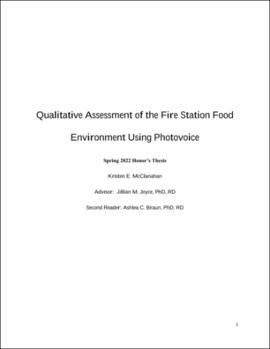| dc.contributor.author | McClanahan, Kristen E. | |
| dc.date.accessioned | 2022-04-28T20:10:35Z | |
| dc.date.available | 2022-04-28T20:10:35Z | |
| dc.date.issued | 2022-04-22 | |
| dc.identifier | oksd_mcclanahan_HT_2022 | |
| dc.identifier.uri | https://hdl.handle.net/11244/335381 | |
| dc.description.abstract | Objective: Cardiovascular events are the leading cause of death for on-duty firefighters. Studies evaluating modifiable risk factors to mitigate this dismal outcome are nascent. Limited qualitative data suggest fire station food environments are 'toxic' and demand attention. Further defining both objective evaluations of the food environment and associated perceptions among firefighters are essential for development of interventions. The objective of this study was to define the fire station food environment using a novel approach | |
| dc.description.abstract | Methods: This cross-sectional study employed Photovoice to document food environment healthfulness of four fire stations within a rural Midwest career fire department. Photos of the fire station food environment were taken in the 'voice' of firefighters and researchers. Details surrounding timing, fire station, shift, food location, and voice were captured for each photo. Photos were then coded deductively based on criteria selected a priori, including presence of Healthy Eating Index 2015 (HEI) components for dietary quality (DQ) and behavioral economics techniques (BET) supporting foods in photos. NVivo qualitative analysis software was used for analysis. Descriptive statistics summarized frequency of codes and photo details. Chi-square was used to compare frequency of codes across photo details. | |
| dc.description.abstract | Results: Analysis included 40 images. Based on preliminary results, there were 273 total coded references. Moderation HEI components and BET promoting them were the most frequent codes: low DQ food is normal (10.3% of coded references), added sugar (9.9%), low DQ food is convenient (9.2%), low DQ foods are attractive (8.8%), saturated fat (8.4%), and sodium (8.4%). Adequacy HEI components and BET promoting them were less frequently coded: total fruit (1.5%), whole fruit (1.5%), whole grains (1.8%), and dark greens and legumes (2.2%). | |
| dc.description.abstract | Conclusions: Results confirm existing data that fire station food environments support low DQ food choices. The most common coded references were low DQ food is normal, attractive, and convenient, as well as presence of added sugar, saturated fat, and sodium. The least common coded references included presence of fruits, whole grains, and dark greens and legumes and their promotion. This indicates an unhealthy, obesogenic food environment. | |
| dc.format | application/pdf | |
| dc.language | en_US | |
| dc.rights | Copyright is held by the author who has granted the Oklahoma State University Library the non-exclusive right to share this material in its institutional repository. Contact Digital Library Services at lib-dls@okstate.edu or 405-744-9161 for the permission policy on the use, reproduction or distribution of this material. | |
| dc.title | Qualitative assessment of the fire station food environment using photovoice | |
| osu.filename | oksd_mcclanahan_HT_2022.pdf | |
| osu.accesstype | Open Access | |
| dc.type.genre | Honors Thesis | |
| dc.type.material | Text | |
| dc.contributor.director | Joyce, Jillian M. | |
| dc.contributor.facultyreader | Braun, Ashlea C. | |
| thesis.degree.discipline | Nutritional Sciences | |
| thesis.degree.grantor | Oklahoma State University | |
